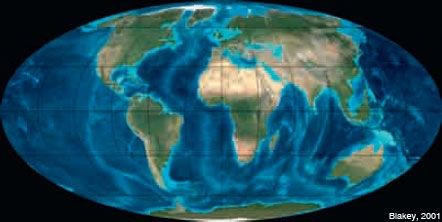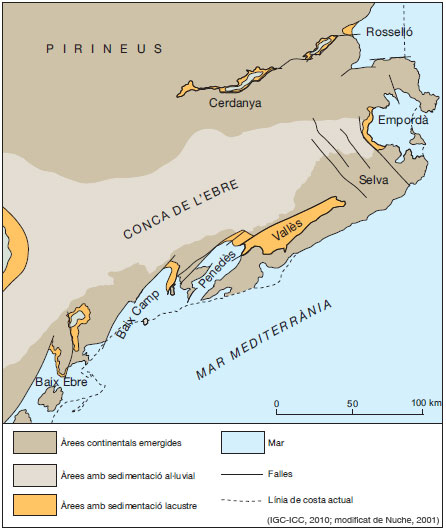Towards the end of the Oligocene and the beginning of the Miocene, some 25 Ma ago, the collision process between the Iberian and European plates had finished. The Pyrenees, the Catalan Coastal Range and the Iberian Range already had the same fold structure as they present day. The sediments that formed the alluvial fans, which had been deposited at the foot of the mountain fronts of the Pyrenees, were now folded forming spectacular progressive unconformities. The Ebro Basin maintained an endorheic regimen with the eastern area, or Central Catalan Basin, totally filled and occupied by an extensive alluvial plain which drained towards the west, where the lacustrine conditions are maintained. To the east, the old Gulf of Tethys had been practically disconnected from the rest of the ocean and an interior sea had been formed, the Paleomediterranean (figure 13).
The end of the collision process between the Iberian and European plates caused, from the late Oligocene onwards, the convergence between Africa and Eurasia to manifest itself more to the south, on the limit between the Iberian and African plates. At the same time a fault system in an extensional geodynamic context was developed. This progressed though the interior of the European Plate from north to south, forming rift valleys in the actual Rhine and Rhone valleys. This new situation originated a series of events that should determine the rest of the basic geological features that configure the actual Catalan area of the Iberian Plate.
The faults that had been formed in the Catalan Coastal Range simultaneously with the formation of the Pyrenees acted in the new extensional tectonic context as normal faults and they generated deep tectonic grabens which were parallel, and also oblique, with respect to the coastline. At the eastern end of the Ebro Basin, normal faults were also developed, in a NW-SE direction. The evolution of the fault systems first provoked the thinning of the continental crust and the fragmentation of the eastern end of the Iberian Plate, in such a way that the block formed by Corsica, Sardinia and the Balearics was separated and started to drift towards the east, due to the formation of oceanic crust in the Gulf of Lion and in the Valencia Trough. In this way, the formation of the actual western Mediterranean started some 20 Ma ago. It was then when the tectonic grabens recently formed in the Catalan Coastal Range and in the eastern end of the actual Pyrenees were connected with the newly developed Mediterranean (figure 14). They were immediately occupied by a shallow sea where clastic and evaporite sediments were deposited and also some coral reefs grew up.
During the late Miocene, in the eastern Pyrenean area, another graben system was generated which severed all fold and thrust structures that had been formed earlier, and which delimited small intermontane sedimentary basins. In the Seu d’Urgell and the Cerdanya basins, systems of alluvial fans with marshy and lacustrine areas were formed, in an endorheic regime, where fine-grained sediments and peat were deposited. In the eastern end of the Ebro Basin, some 10 Ma ago, the start of the basic eruptive episode in favour of the faults oriented NW-SE that delimit the Empordà graben was registered. The basaltic flows from the volcanic activity still remain.

 Contact
Contact








